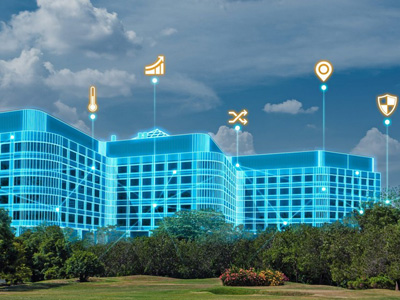Solution

A smart building is one that uses sensing technology to enable energy-saving and economical management. Smart buildings may use a wide range of existing technologies such as pressure sensors and environmental transmitters, building management systems, Internet and Wifi, artificially intelligent software, This is what makes a building “smart” – the ability of the systems within it to communicate to one another.
A smart building is any structure that uses automated processes to automatically control the building’s operations including heating, ventilation, air conditioning, lighting, security and other systems. A smart building uses sensors, actuators and microchips, in order to collect data and manage it according to a business’ functions and services. This infrastructure helps owners, operators and facility managers improve asset reliability and performance, which reduces energy use, optimizes how space is used and minimizes the environmental impact of buildings.
The most fundamental feature of a smart building is that the core systems within it are linked. Connecting smart technology, such as real-time IoT occupancy sensors and building management systems together, means you can share information that can be used to automate various processes, including, but not limited to, heating, ventilation, lighting, air conditioning, and security.
The advantages of smart building
Increased productivity
Create a space that facilitates good indoor air quality, physical comfort, security, sanitation, lighting, efficient processes, and the room that staff need at an optimum level will enable them to perform well. Most people cannot keep concentration and accurate determination in a space with bad air, uncomfortable humidity temperature, and dim illumination, and noisy strange guests.
One example of energy efficiency is the use of optimal start/stop, which allows the building automation system to learn when it should bring the air conditioning system online for a particular zone in the building. Another feature is electrical loads that are grouped into categories from critical to high priority to non-essential.
Reduce energy consumption
Smart buildings allow you to improve your energy efficiency, and, in turn, energy costs. By connecting sensors that monitor occupancy with your building management system, you can automatically turn off lights or HVAC systems in unoccupied rooms or spaces to reduce the need for unnecessary consumption of energy these aspects emit. These benefits range from energy savings to productivity gains to sustainability. Smart building strategies can reduce energy costs, increase the productivity of the facility staff, improve building operations, support sustainability efforts and enhance decision-making across the organization.
Reduce operating costs
Building overheads are a significant cost for any building owner/user. However, while these are necessary business expenses, the level of spend is often wasteful because it’s not intelligently applied. By identifying patterns around underutilized spaces, you can reduce real estate to cut costs.
Related Products
More Solutions
 English
English  français
français  Deutsch
Deutsch  Español
Español  italiano
italiano  русский
русский  português
português  العربية
العربية  Türkçe
Türkçe  Zulu
Zulu 